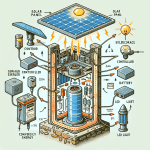Design and Aesthetics of Solar Bollards
-
Table of Contents
Solar bollards are an innovative fusion of functionality and design, serving as both lighting solutions and aesthetic enhancements for outdoor spaces. These self-contained units harness solar energy to provide illumination, making them an eco-friendly and cost-effective alternative to traditional lighting. The design of solar bollards often emphasizes sleek, modern lines and durable materials, ensuring they blend seamlessly into various landscapes while withstanding environmental elements. Aesthetically, they can range from minimalist and contemporary to more ornate and decorative styles, catering to diverse architectural preferences. The integration of advanced solar technology with thoughtful design not only enhances the visual appeal of public and private spaces but also promotes sustainability and energy efficiency.
Innovative Design Trends in Solar Bollards
How Have the Design and Aesthetics of Solar Bollards Evolved?
The design and aesthetics of solar bollards have evolved significantly in recent years, reflecting broader trends in both technology and urban design. As cities and communities increasingly prioritize sustainability, the integration of solar-powered lighting solutions has become more prevalent. Solar bollards, in particular, have emerged as a popular choice for outdoor lighting due to their energy efficiency, low maintenance, and minimal environmental impact. This shift towards solar bollards is not merely functional but also deeply rooted in innovative design trends that enhance both their utility and visual appeal.
What Are the Trends in the Aesthetic Design of Solar Bollards?
One of the most notable trends in the design of solar bollards is the emphasis on sleek, modern aesthetics. Designers are moving away from bulky, utilitarian forms and instead opting for streamlined shapes that blend seamlessly with contemporary urban landscapes. This minimalist approach not only enhances the visual harmony of public spaces but also ensures that the bollards do not detract from the natural beauty of their surroundings. By employing clean lines and understated elegance, solar bollards can complement a wide range of architectural styles, from historic to avant-garde.
How Have the Materials Used in Solar Bollards Advanced?
In addition to their refined appearance, the materials used in the construction of solar bollards have also seen significant advancements. High-quality, durable materials such as stainless steel, aluminum, and tempered glass are now commonly used, providing both longevity and a premium look. These materials are often chosen for their ability to withstand harsh weather conditions, ensuring that the bollards remain functional and attractive over time. Moreover, the use of recyclable and eco-friendly materials aligns with the broader sustainability goals that solar bollards inherently support.
What Technological Innovations Have Been Integrated into Solar Bollards?
Another key aspect of innovative design in solar bollards is the integration of advanced technology. Modern solar bollards are equipped with high-efficiency photovoltaic panels that maximize energy capture even in low-light conditions. This technological enhancement ensures that the bollards provide consistent illumination throughout the night, regardless of weather variations. Furthermore, many solar bollards now feature smart technology, such as motion sensors and programmable lighting schedules, which optimize energy usage and enhance security. These intelligent features not only improve the functionality of the bollards but also contribute to a safer and more energy-efficient environment.
What Customization Options Are Available for Solar Bollards?
The customization options available for solar bollards have also expanded, allowing for greater flexibility in design and application. Customizable features such as color temperature, light distribution patterns, and decorative elements enable designers to tailor the bollards to specific project requirements. This level of customization ensures that solar bollards can be effectively integrated into a variety of settings, from pedestrian pathways and parks to commercial plazas and residential areas. By offering a range of design options, manufacturers can meet the diverse needs of different communities while maintaining a cohesive aesthetic.
How Do Solar Bollards Contribute to Placemaking?
Furthermore, the role of solar bollards in placemaking cannot be overlooked. Thoughtfully designed solar bollards can enhance the identity and character of a space, creating a sense of place and fostering community engagement. For instance, bollards with artistic elements or thematic designs can serve as visual landmarks, contributing to the cultural and aesthetic value of public areas. This approach not only elevates the functional role of solar bollards but also enriches the overall experience of the space for residents and visitors alike.
In conclusion, the innovative design trends in solar bollards reflect a harmonious blend of form and function. By prioritizing sleek aesthetics, durable materials, advanced technology, and customization, designers are creating solar bollards that are not only efficient and sustainable but also visually appealing and contextually relevant. As urban environments continue to evolve, the thoughtful integration of solar bollards will play a crucial role in shaping sustainable, attractive, and vibrant public spaces.
Enhancing Outdoor Spaces with Aesthetic Solar Bollards

How Do Solar Bollards Enhance Outdoor Spaces?
Solar bollards have emerged as a sophisticated solution for enhancing outdoor spaces, seamlessly blending functionality with aesthetic appeal. These innovative lighting fixtures are not only environmentally friendly but also contribute significantly to the visual and practical enhancement of various landscapes. As urban areas and private properties increasingly prioritize sustainability, the design and aesthetics of solar bollards have become crucial in achieving a harmonious balance between ecological responsibility and visual elegance.
What Are the Environmental Benefits of Solar Bollards?
One of the primary advantages of solar bollards is their ability to harness solar energy, thereby reducing reliance on conventional power sources. This eco-friendly feature is particularly appealing in an era where sustainability is paramount. By converting sunlight into electricity, solar bollards provide a renewable source of illumination that minimizes carbon footprints. This aspect alone makes them an attractive option for municipalities, businesses, and homeowners who are committed to green initiatives.
How Do Solar Bollards Combine Aesthetics with Functionality?
In addition to their environmental benefits, solar bollards are designed with a keen eye for aesthetics. Modern designs incorporate sleek lines, contemporary materials, and versatile finishes that can complement a wide range of architectural styles. Whether installed in a public park, along a residential pathway, or in a commercial plaza, these bollards enhance the visual appeal of the space. The integration of advanced LED technology ensures that the light emitted is both efficient and pleasing to the eye, creating a welcoming ambiance without overwhelming the surroundings.
What Functional Advantages Do Solar Bollards Offer?
Moreover, the versatility of solar bollards extends to their functionality. They are available in various heights, shapes, and light intensities, allowing for customization based on specific needs and preferences. For instance, shorter bollards can be used to delineate pathways, while taller ones can provide broader illumination for larger areas. This adaptability makes them suitable for diverse applications, from guiding pedestrians safely through dark areas to highlighting landscape features such as gardens and sculptures.
How Easy Is the Installation Process for Solar Bollards?
The installation process of solar bollards is another aspect that adds to their appeal. Unlike traditional lighting systems that require extensive wiring and trenching, solar bollards are relatively easy to install. They can be placed in virtually any location with adequate sunlight exposure, reducing both installation time and costs. This convenience is particularly beneficial for retrofitting existing spaces or for use in remote areas where access to electrical infrastructure is limited.
What Makes Solar Bollards Durable and Low Maintenance?
Furthermore, the durability and low maintenance requirements of solar bollards contribute to their growing popularity. Constructed from robust materials such as stainless steel, aluminum, and high-impact plastics, these fixtures are designed to withstand harsh weather conditions and resist vandalism. The use of long-lasting LED bulbs also means that they require minimal maintenance, providing reliable performance over extended periods.
In conclusion, the design and aesthetics of solar bollards play a pivotal role in enhancing outdoor spaces. Their ability to combine environmental sustainability with visual and functional benefits makes them an ideal choice for a variety of settings. As technology continues to advance, it is likely that solar bollards will become even more efficient and versatile, further solidifying their place as a key element in the landscape design toolkit. By choosing solar bollards, communities and individuals can create beautiful, well-lit environments that reflect a commitment to both aesthetic excellence and ecological responsibility.
Sustainable and Stylish: The Dual Benefits of Solar Bollards
Solar bollards, increasingly prevalent in urban landscapes, represent a harmonious blend of sustainability and aesthetic appeal. These innovative lighting solutions are not only functional but also contribute significantly to environmental conservation. The design and aesthetics of solar bollards are pivotal in their adoption, as they seamlessly integrate into various settings while providing eco-friendly illumination.
The primary allure of solar bollards lies in their ability to harness solar energy, thereby reducing reliance on conventional power sources. This sustainable approach is particularly advantageous in mitigating the carbon footprint associated with traditional lighting systems. By converting sunlight into electrical energy, solar bollards operate independently of the grid, ensuring continuous illumination even during power outages. This self-sufficiency is a testament to their efficiency and reliability, making them an ideal choice for public spaces, pathways, and gardens.
Transitioning from functionality to design, solar bollards are crafted with meticulous attention to detail. Their sleek and modern appearance enhances the visual appeal of any environment. Available in a variety of styles, materials, and finishes, these bollards can be customized to complement the architectural aesthetics of their surroundings. For instance, stainless steel bollards exude a contemporary vibe, while wooden or stone finishes blend seamlessly with natural landscapes. This versatility ensures that solar bollards are not merely utilitarian objects but also integral components of landscape design.
Moreover, the integration of advanced technology in solar bollards further elevates their appeal. Many models are equipped with sensors that adjust the light intensity based on ambient conditions, thereby optimizing energy usage. This intelligent lighting system not only conserves energy but also enhances safety by providing adequate illumination when needed. Additionally, the use of LED lights in solar bollards ensures longevity and minimal maintenance, as LEDs are known for their durability and low energy consumption.
In terms of installation, solar bollards offer significant advantages over traditional lighting systems. Their wireless nature eliminates the need for extensive wiring and trenching, thereby reducing installation costs and time. This ease of installation makes them particularly suitable for remote or hard-to-reach areas where conventional lighting infrastructure may be impractical. Furthermore, the modular design of solar bollards allows for easy replacement or upgrading of components, ensuring long-term sustainability.
The environmental benefits of solar bollards extend beyond energy conservation. By reducing the demand for electricity generated from fossil fuels, they contribute to a decrease in greenhouse gas emissions. This aligns with global efforts to combat climate change and promote renewable energy sources. Additionally, the use of recyclable materials in the construction of solar bollards underscores their eco-friendly nature, further enhancing their appeal to environmentally conscious consumers.
In conclusion, the design and aesthetics of solar bollards play a crucial role in their widespread adoption. Their ability to combine sustainability with style makes them a valuable addition to any landscape. By providing efficient, reliable, and eco-friendly illumination, solar bollards exemplify the dual benefits of sustainable technology and aesthetic enhancement. As urban planners and designers continue to prioritize green solutions, the popularity of solar bollards is likely to grow, illuminating the path towards a more sustainable future.
Read more about Solar Bollards:
- Introduction to Solar Bollards
- How Do Solar Bollards Work?
- Maintenance and Durability of Solar Bollards
- Applications of Solar Bollards
- Choosing the Right Solar Bollard for Your Needs
- Installation and Wiring of Solar Bollards
- Integration of Solar Bollards with Smart Technology
- Comparison of Solar Bollards with Traditional Lighting Solutions
- Regulations and Standards for Solar Bollards








